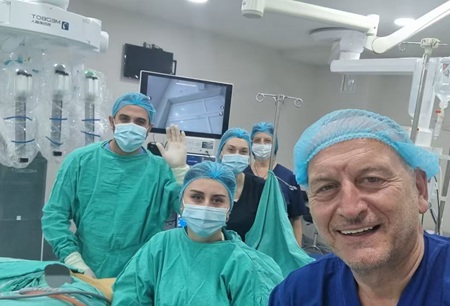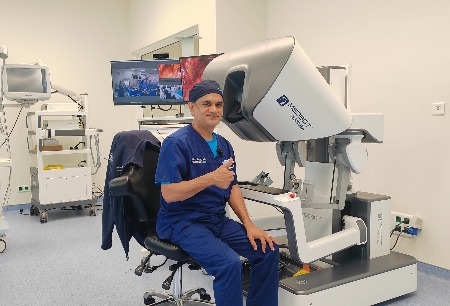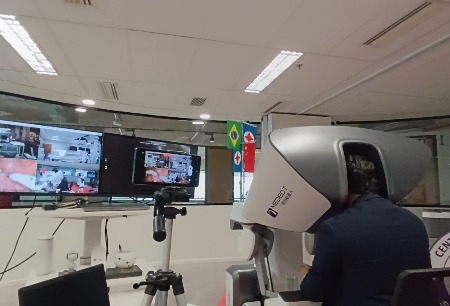"End the surgery and remove the machine!" With a instruction from Prof. Boyong Shen at the operating table, the Pancreatic Surgery Department of Ruijin Hospital has achieved a complete success in another pancreatic surgery with the Chinese-developed Toumai® laparoscopic surgical robot. Recently, the Pancreatic Surgery Department of Ruijin Hospital has successfully completed 5 distal pancreatectomies relying on this system, which indicates that the Chinese-developed laparoscopic surgical robot can be safely applied in pancreatic surgery.
Toumai® laparoscopic surgical robot is equipped with four robot arms, and the head end of the instruments can move freely to precisely simulate the movement of human hands, which can achieve precise clamping and complete multiple steps such as cutting, coagulation and freeing in the surgical operation. At present, the system has obtained the medical device manufacturing license and product registration certificate issued by the National Health Commission, and can be used in urological surgery, and has completed commercial production and sale. However, this is the first time such a large sample has been used in the field of pancreatic surgery.
"This machine is very good, and I'm sure that with familiar and accustomed operation, the most common surgeries in general surgery like pancreaticoduodenectomy can be done with this system well." Prof. Boyong Shen said that since 2020, he has provided clinical advice on the R&D and application of Toumai® laparoscopic surgical robot as an invited expert, and has been deeply involved in the development of the system. Before the use of the Toumai®, he was a little concerned about delays in operation and a small range of motion, but with the success of the first surgery, his concerns gradually dissipated.
Since the end of the last century, robotic surgery systems have been continuously developed and widely used in almost all surgery-related departments such as general surgery, thoracic surgery, gynecology and urology, and their safety and effectiveness have been fully proved. Due to the precise and flexible operation by its smart robotic arm, in addition to giving patients small incisions and micro-trauma, it also brings surgeons a better surgical experience than laparoscopic surgery, reducing the physical consumption of surgeons, and gradually becoming one of the first choices for surgeons in mini-invasive surgery. Since the technology was adopted in China in 2009, nearly 300,000 cases of various robotic surgeries have been completed, with robotic pancreatic surgery leading other countries in terms of both the number and quality of surgeries. Since 2015, the state has encouraged technology companies to design and develop domestic robotic surgery systems with independent intellectual property rights. The Toumai® laparoscopic surgical robot of Shanghai MicroPort MedBot (Group) Co., Ltd. was developed in this context, and Prof. Boyong Shen of Ruijin Hospital is the former president of the Society of Robotic Surgery.
It is reported that the pancreas surgery carried out in Ruijin Hospital has been strongly supported by the "Science and Technology Innovation Action Plan" high-tech field project of Shanghai Science and Technology Commission. The completed surgeries have confirmed that the Toumai® can meet the surgical requirements of pancreatic surgery, providing a theoretical basis for further promotion of the domestic robotic surgery system. Going forward, the Pancreatic Surgery Department of Ruijin Hospital will complete a total of 15 cases of distal pancreatectomies and 5 cases of other pancreatic surgeries, and will become the first tertiary hospital in China to complete pancreatic surgery with a large sample of the Toumai®laparoscopic surgical robot.
-
 2024-11-18Karazanashvili Robotic Center Completed 100 Toumai® Robot-Assisted Surgeries, becoming the Only Robotic Surgery Center in the Caucasus Region
2024-11-18Karazanashvili Robotic Center Completed 100 Toumai® Robot-Assisted Surgeries, becoming the Only Robotic Surgery Center in the Caucasus Region -
 2024-10-26TOUMAI® SURGICAL ROBOT SYSTEM COMPLETES MULTIPLE LANDMARK ROBOTIC TELESURGERY CASES IN SUB-SAHARA AFRICA IN THE REPUBLIC OF ANGOLA
2024-10-26TOUMAI® SURGICAL ROBOT SYSTEM COMPLETES MULTIPLE LANDMARK ROBOTIC TELESURGERY CASES IN SUB-SAHARA AFRICA IN THE REPUBLIC OF ANGOLA -
 2024-10-26Toumai® Achieves South America's First Tele-Surgery Demonstration
2024-10-26Toumai® Achieves South America's First Tele-Surgery Demonstration






 Hu ICP Bei No. 20013662 HGWA Bei No. 31011502015178
Hu ICP Bei No. 20013662 HGWA Bei No. 31011502015178 " are registered trademarks of Shanghai MicroPort Medical (Group) Co., Ltd.” . They have been authorized to be used by Shanghai Microport Medbot (Group) Co., Ltd., and no other party shall use such trademarks without prior written permission thereof.
" are registered trademarks of Shanghai MicroPort Medical (Group) Co., Ltd.” . They have been authorized to be used by Shanghai Microport Medbot (Group) Co., Ltd., and no other party shall use such trademarks without prior written permission thereof.
